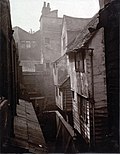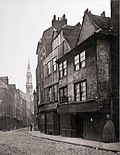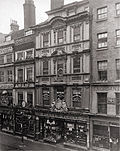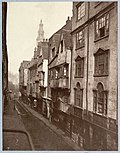User:Paravane/sandbox
This list of demolished buildings and structures in London lists buildings, structures and urban scenes of particular architectural, historical, scenic or social interest in London which have been demolished or which were destroyed by bombing in World War II.
Old photographs, prints and paintings provide some insight into how London has changed.
| Name |
Date of construction |
Date of destruction |
Image | Location | Notes |
|---|---|---|---|---|---|
| Adelphi Buildings | 1768-72 | 1930s | 
|
Adelphi | A neo-classical terrace of 24 houses by the Adam brothers. |
| Barnard's Inn | 17th Century | After 1879 | 
|
Fetter Lane | Former Inn of Chancery. Hall still survives, owned by Gresham College. |
| Bridewell Palace | 16-17th Century | 1863-4 | 
|
Blackfriars | Residence of Henry VIII 1515–1523, prison and hospital from 1556, largely rebuilt after the Great Fire of London, closed 1855.[1] |
| Cloth Fair | 17th Century | 1917 | 
|
Smithfield | An area of old houses and narrow lanes adjoining the church of St Bartholomew-the-Great. One 17th century house survives. |
| Clifford's Inn | 18th Century | 1934 | 
|
Fleet Street | The longest surviving Inn of Chancery, founded in 1344, dissolved in 1903. Only the gatehouse remains. |
| Crystal Palace | 1851 | 1936 | 
|
Hyde Park | Built by Joseph Paxton for the Great Exhibition of 1851, rebuilt in different form in South London 1854, destroyed by fire. |
| Devonshire House | c 1740 | 1924 | 
|
Piccadilly | Built by William Kent for the Dukes of Devonshire |
| Dorchester House | 1853 | 1929 | 
|
Park Lane | Palatial house built by Robert Stayner Holford, replaced by the Dorchester Hotel. |
| Drury Lane | 17th Century | 1890 | 
|
Drury Lane | Old houses including the former 'Cock and Magpie' tavern (with sign), which had become Stockley's Bookshop by 1876.[2] |
| East India House | 1729 | 1861 | 
|
Leadenhall Street | Designed by merchant and amateur architect Theodore Jacobsen. Much of British India was governed from here until the British government took control in 1858. |
| Newgate Prison | 1770-82 | 1904 | 
|
Old Bailey | First built in 1188, closed 1902, the Central Criminal Court now stands on the site. |
| Northumberland House | c 1605 | 1874 | 
|
Trafalgar Square | London residence of the Dukes of Northumberland. |
| Old London Bridge | 12th-17th Century | 1758-1831 | 
|
River Thames | Houses on the bridge were demolished in 1758-62, the bridge itself following the completion of a new bridge by James Rennie in 1831. |
| Old Mansion House | 1668 | 1929 | 
|
Cheapside | Built by Sir Christopher Wren for Sir William Turner, Lord Mayor of London 1668-9. |
| Old St Paul's Cathedral | 1087–1314 | 1666 | 
|
Ludgate Hill | Severely in decline by the 17th century, destroyed in the Great Fire of London. |
| Oxford Arms, Warwick Lane | 17th Century | 1876 | 
|
City of London | One of the last surviving galleried inns in London. |
| Queen Square | 1716-1725 | 19th Century | 
|
Bloomsbury | Many of the original houses were converted for use as hospitals. The square today is largely occupied by hospital buildings. |
| Regent Street | 1814-25 | 1895-1927 | 
|
Regent Street | Originally built by John Nash as a new thoroughfare, entailing much demolition, completely redeveloped 1895-1927. |
| River Fleet | 17-18th Century | 18-19th Century | 
|
Blackfriars | River converted into New Canal by 1680; covered over, in part by New Bridge Street, prior to opening of Blackfriars Bridge in 1769. |
| Royal Panopticon | 1854 | 1882 | Leicester Square | Showcase venue for the best achievements in Science and Arts of the time, converted to theatre after only 2 years. Destroyed by fire. | |
| Sir Paul Pindar's House | 17th Century | 1890 | 
|
Bishopsgate | Became a tavern in the 18th Century, frontage preserved in the Victoria and Albert Museum. |
| Whitehall Palace | 15-17th Century | 1698 | 
|
Whitehall | Largest palace in Europe, London residence of the English monarchs 1530-1698, all except Banqueting House destroyed by fire. |
| Wych Street | 16-17th Century | 1901 | 
|
Aldwych | Part of the area around Drury Lane which survived the Great Fire of London, the street contained decrepit Elizabethan houses, with projecting wooden jetties. |
References[edit]
- ^ "Bridewell Palace" Pastscape. Retrieved March 31, 2012.
- ^ "Drury Lane and Clare Market" British History Online. Retrieved March 31, 2012.

